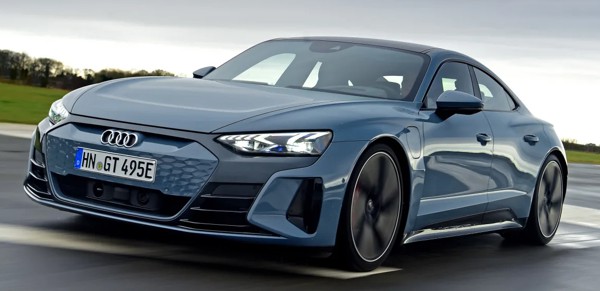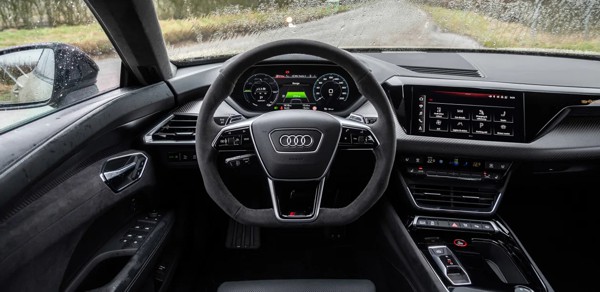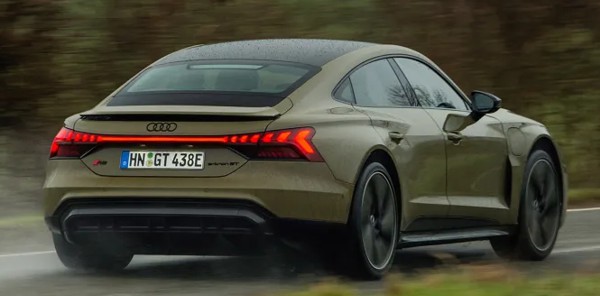Published
on 26
Mar 2021
|
All rights reserved.
|
|
|

|
|
The
E-tron GT shares all mechanical and electrical bits with Porsche
Taycan, yet it has its own personality.
|
|
When R8 is cruising to
retirement, E-tron GT emerges as Audi’s halo model in the new electric
era. Well, a 4-door, 2.3-ton grand tourer can never replace a
V10-powered mid-engined supercar, but it is closer to a sports car than
you might think. If you don’t believe, just look at Porsche Taycan. It
is no secret that Audi E-tron GT is the sister car of Taycan. Both
share the J1 platform with the same battery, electric drivetrain,
suspension and even the same proportion. You may see it as a slightly
slower but more luxurious kind of Taycan. However, they do not share
the same production line. The Audi is built in the Böllinger
Höfe facility near Neckarsulm, sharing the same production line
with the R8, remarkably. Meanwhile, the Taycan is built at the
Zuffenhausen main plant of Porsche.
The E-tron GT is slightly longer and taller than its Porsche sister,
but they share a wide and low-slung proportion. Therefore, it looks
slimmer and lighter than, say, an A7. Predictably, Audi applies its own
design language so that you won’t notice its association with Taycan.
While the Porsche is smooth and curvy, the Audi is edgier, has sharper
flanks and a more angular nose. Perhaps that is why its 0.24 Cd is not
quite as outstanding as Porsche’s 0.22. Personally, I prefer the
styling of Taycan, as it is more original and coherent. In contrast,
the Audi’s front end is a bit busy. It tries hard to look stylish, but
the styling elements are neither elegant nor innovative. That said, the
biggest appeal of its exterior remains to be that sleek proportion.

|
|
The
cabin has no trace of Porsche, everything is unique and finished in
Audi’s fashion.
|
|
The
table turns in the interior. Again, you won’t tell it is derived from
Porsche. Many car makers save money by sharing interior parts across
their platform-mates. Not here, because Audi and Porsche know very well
the importance of differentiating their personalities, something
crucial to luxury car business. The E-tron GT’s cabin is completely
new. Although it is governed by the same hardpoints, such as the
prominent transmission tunnel and the same wheelbase, the dashboard,
the console, the digital instrument panel, the door panels and actually
every surface are unique. In fact, they have more in common with other
high-end Audis, even sharing the same touchscreen. Moreover, while
Porsche relies on 2 touchscreens to do everything, the Audi offers only
one touchscreen, leaving good old hardware buttons and dials to control
the air-con and audio, which is actually more ergonomically sounded. On
the downside, you might say this cabin looks a bit conventional,
something many other rivals deliberately avoided in their EVs. Build
quality is typical Audi grade, but the choices of materials aren’t as
luxurious as you might expect for a high-end Audi, which is a missed
opportunity to distinguish itself from Taycan.
Like the Porsche, you sit lower than other EVs in the E-tron GT, giving
a sportscar feel. Despite standard panoramic roof (you may opt for
carbon-fiber roof to save a few kilograms from its highest point) and
batteries located underneath your bum, the car offers plenty of
headroom, a bit more than Porsche. Rear legroom is also good, thanks to
carving out rear footwells from the skateboard floorpan. Although the
frunk and truck are shallow, they are slightly larger than those of
Taycan.
|
|
|
The
RS model turns into corner with a sharpness this side of the R8...
|
|
As in Taycan, the 93.4kWh worth of battery is located under
floor and the rear seat (smaller battery option will follow). Like
Porsche, too, the Audi is launched with two top-of-the-line models:
E-tron GT and RS E-tron GT. Their prices start from £80,000 and
£110,000, respectively, slightly cheaper than Taycan and R8. Both
models employ twin-motors for 4-wheel drive, and the rear one is about
twice as powerful as the front. The E-tron GT produces 476 hp and 464
lbft, but in launch mode it can be “overboosted” to 530 hp and 472 lbft
for 2.5 seconds, sufficient to record 0-60 in 4.0 seconds. Top speed is
capped at 152 mph. See it as an equivalent of Taycan 4S with long-range
battery.
Meanwhile, RS model runs a more powerful rear motor, lifting its output
to 598 hp or 646 hp in short overboost, accompanied with 612 lbft of
torque. It is able to crack 60 mph in 3.2 seconds and top a regulated
155 mph. That’s marginally less powerful and slower than a Taycan
Turbo. It goes without saying Porsche won’t let its Audi sister to
touch the territory of Turbo S.
The duo can travel around 480 km or 300 miles, slightly longer than
Porsche. 800VDC / 270 kW quick charging is standard.
Most mechanical parts are taken from the arsenal of Porsche, including
a 2-speed gearbox for the rear motor (unusual for an EV),
height-adjustable 3-chamber air suspensions and 4-wheel steering
option. The base model is equipped with rear LSD, while RS model comes
with an active differential. Braking is provided by steel discs on the
base model, while cast iron discs with carbide coating serve RS.
Carbon-ceramic brakes are optional.

|
|
Calmer
steering and looser body control makes it less sporty than Porsche, but
it makes a lot of sense as a 4-door GT or sports sedan.
|
|
On the
road, as expected, the E-tron GT is quick, while RS model feels as
quick as a conventional supercar, thanks to that relentless stream of
torque. However, the acceleration is not quite as violent as the Taycan
Turbo S, which is why it takes 3.2 instead of 2.6 seconds to propel you
from rest to 60 mph. It feels more progressive, less like a surge from
off to on. Less thrilling that might be to some, but it is still fast
enough to surprise people used to conventional motors.
As for chassis, Audi also tuned it to feel like an Audi. Compared with
Taycan, its steering is lighter, especially on center. Kickbacks are
better filtered out, giving a calmer and more relaxing feel. As the
helm is less talkative, you don’t need to make constant corrections.
Less involving it might be, once you give it some lock, it still
responds positively with directness and precision.
Likewise, the Audi’s suspension is a tad softer than Porsche’s. It
doesn’t control its motions quite as tightly, displaying more roll in
cornering and pitch in hard braking, but still it is firm and composed
enough to have fun on challenging roads. The adjustable air suspension
broadens its ability. In Comfort, it rides pliantly on B-roads.
Sportier modes keep it stable in faster turns. Most important, with two
motors and an active differential, the RS model turns into corner with
a sharpness this side of the R8. Understeer is all but dialed out.
Ultimately, the 2.3-ton of car still stops you from feeling like
driving a sports car. Its calmer steering and looser body control make
this task less accomplished than its Porsche sister.
As a 4-door GT or sports sedan, however, it makes a lot of sense. More
attractive and better to drive than a Tesla Model S, more comfortable
and affordable than Porsche Taycan, and more advanced-feeling than an
AMG GT 4-door, it finds a unique market space. That said, the E-tron GT
might be more sensible when it expands the range downward. If an
entry-level model with 400hp, single motor, RWD and 79kWh battery (like
the base Taycan) can be bought at £65,000, it will be truly a
steal.
|
Verdict:     |
|